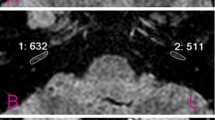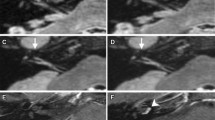Abstract
The aim of this study was to confirm the feasibility of high signal on three-dimensional fluid-attenuated inversion recovery magnetic resonance imaging (3D FLAIR MRI) as one of the prognostic factors in recovery of sudden idiopathic hearing loss. A retrospective study was conducted using patients who were diagnosed with unilateral sudden idiopathic hearing loss from January 2008 to December 2010. A total of 120 patients were enrolled in for this study. High-intensity signal in the inner ear on precontrast 3D FLAIR MRI was observed in 31 patients (25.8%; FHS) and labyrinthine enhancement was not observed in another 89 patients (FNS; 74.2%). There was no significant difference in patients’ characteristics between two groups except final hearing. Final puretone average of the FHS group was 49.4 dB, significantly worse than FNS group’s 36.7 dB (p = 0.037 < 0.05). Final hearing was related to initial hearing, accompanying dizziness, and abnormal auditory brainstem response result by multiple regression analysis. However, presence of high-intensity signal on precontrast 3D FLAIR MRI did not affect final hearing significantly. Significant difference due to the presence of dizziness in final hearing was observed in whole patients and in the FHS group, whereas no significant difference in final hearing was observed in FNS group. (p = 0.063 > 0.05). From these findings, the presence of high-intensity signal on 3D FLAIR MRI is a subfactor related to dizziness rather than a single poor prognostic factor and the absence of high-intensity signal on 3D FLAIR MRI can possibly imply relative good prognosis.





Similar content being viewed by others
References
Hughes GB, Freedman MA, Haberkamp TJ, Guay ME (1996) Sudden sensorineural hearing loss. Otolaryngol Clin North Am 29:393–403
Byl FM Jr (1984) Sudden hearing loss: eight years’ experience and suggested prognostic table. Laryngoscope 94:647–661
Jang CH, Kim YH (2004) Sudden hearing loss in intralabyrinthine haemorrhage in a child. J Laryngol Otol 118:450–452
Xenellis J, Karapatsas I, Papadimitriou N, Nikolopoulos T, Maragoudakis P, Tzagkaroulakis M et al (2006) Idiopthic sudden sensorineural hearing loss: prognostic factors. J Laryngol Otol 120:718–724
Cvorović L, Deric D, Probst R, Hegemann S (2008) Prognostic model for predicting hearing recovery in idiopathic sudden sensorineural hearing loss. Otol Neurotol 29:464–469
Cadoni G, Agostino S, Scipione S, Ippolito S, Caselli A, Marchese R et al (2005) Sudden sensorineural hearing loss: our experience in diagnosis, treatment, and out come. J Otolaryngol 34:395–401
Yoshida T, Sugiura M, Naganawa S, Teranishi M, Nakata S, Nakashima T (2008) Three-dimensional fluid-attenuated inversion recovery magnetic resonance imaging findings and prognosis in sudden sensorineural hearing loss. Laryngoscope 118:1433–1437
Siegel LG (1976) The treatment of idiopathic sudden sensorineural hearing loss. Otolaryngol Clin North Am 8:467–473
Nakata S, Mizuno T, Naganawa S, Sugiura M, Yoshida T, Teranishi M, Sone M, Nakashima T (2010) 3D-FLAIR MRI in facial nerve paralysis with and without audio-vestibular disorder. Acta Otolaryngol 130:632–636
Sugiura M, Naganawa S, Teranishi M, Nakashima T (2006) Three-dimensional fluid attenuated inversion recovery magnetic resonance imaging findings in patients with sudden sensorineural hearing loss. Laryngoscope 116:1451–1454
Naganawa S, Komada T, Fukatsu H, Ishigaki T, Takizawa O (2006) Observation of contrast enhancement in the cochlear fluid space of healthy subjects using a 3D-FLAIR sequence at 3 Tesla. Eur Radiol 16:733–737
Nosrati-Zarenoe R, Arlinger S, Hultcrantz E (2007) Idiopathic sudden sensorineural hearing loss: results drawn from the Swedish national database. Acta Otolaryngol 127:1168–1175
Lee NH, Ban JH (2010) Is BPPV a prognostic factor in idiopathic sudden sensory hearing loss? Clin Exp Otorhinolaryngol 3:199–202
Mattox DE, Lyles CA (1989) Idiopathic sudden sensorineural hearing loss. Am J Otol 10:242–247
Mamak A, Yilmaz S, Cansiz H, Inci E, Güçlü E, Dereköylü L (2005) A study of prognostic factors in sudden hearing loss. Ear Nose Throat J 84:641–644
Mosnier I, Stepanian A, Baron G, Bodenez C, Robier A, Meyer B et al (2011) Cardiovascular and thromboembolic risk factors in idiopathic sudden sensorineural hearing loss: a case-control study. Audiol Neurootol 16:55–66
Ziegler EA, Hohlweg-Majert B, Maurer J, Mann WJ (2003) Epidemiological data of patients with sudden hearing loss—a retrospective study over a period of three years. Laryngorhinootologie 82:4–8
Son EJ, Bang JH, Kang JG (2007) Anterior inferior cerebellar artery infarction presenting with sudden hearing loss and vertigo. Laryngoscope 117:556–558
Hikita-Watanabe N, Kitahara T, Horii A, Kawashima T, Doi K, Okumura S (2010) Tinnitus as a prognostic factor of sudden deafness. Acta Otolaryngol 130:79–83
Danino J, Joachims HZ, Eliachar I, Podoshin L, Ben-David Y, Fradis M (1984) Tinnitus as a prognostic factor in sudden deafness. Am J Otolaryngol 5:394–396
Iwasaki S, Takai Y, Ozeki H, Ito K, Karino S, Murofushi T (2005) Extent of lesions in idiopathic sudden hearing loss with vertigo: study using click and galvanic vestibular evoked myogenic potentials. Arch Otolaryngol Head Neck Surg 131:857–862
Hong SM, Byun JY, Park CH, Lee JH, Park MS, Cha CI (2008) Saccular damage in patients with idiopathic sudden sensorineural hearing loss without vertigo. Otolaryngol Head Neck Surg 139:541–545
Conflict of interest
No financial support in any form have been received or will be received from a commercial party related directly or indirectly to the completion of the work.
Author information
Authors and Affiliations
Corresponding author
Rights and permissions
About this article
Cite this article
Lee, H.Y., Jung, S.Y., Park, M.S. et al. Feasibility of three-dimensional fluid-attenuated inversion recovery magnetic resonance imaging as a prognostic factor in patients with sudden hearing loss. Eur Arch Otorhinolaryngol 269, 1885–1891 (2012). https://doi.org/10.1007/s00405-011-1834-1
Received:
Accepted:
Published:
Issue Date:
DOI: https://doi.org/10.1007/s00405-011-1834-1




